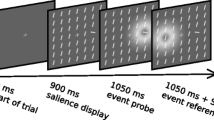Abstract
A theory is developed on the assumption that early sensory processing aims at maximizing the information rate in the channels connecting the sensory system to more central parts of the brain, where it is assumed that these channels are noisy and have a limited dynamic range. Given a stimulus power spectrum, the theory enables the computation of filters accomplishing this maximizing of information. Resulting filters are band-pass or high-pass at high signal-to-noise ratios, and low-pass at low signal-to-noise ratios. In spatial vision this corresponds to lateral inhibition and pooling, respectively. The filters comply with Weber's law over a considerable range of signal-to-noise ratios.
Similar content being viewed by others
References
Attneave F (1954) Some informational aspects of visual perception. Psychol Rev 61:183–193
Barlow HB (1961) Possible principles underlying the transformations of sensory messages. In Rosenblith WA (ed) Sensory communication. MIT Press, Cambridge, pp 217–234
Field DJ (1987) Relations between the statistics of natural images and the response properties of cortical cells. J Opt Soc Am A 4:2379–2394
Goldman S (1953) Information theory. Dover Publications, New York
Hateren JH van (1992a) Theoretical predictions of spatiotemporal receptive fields of fly CMCs, and experimental validation. J CompPhysiol A 171:157–170.
Hateren JH van (1992b) Spatiotemporal contrast sensitivity of early vision. Vision Res, in press
Howard J, Snyder AW (1983) Transduction as a limitation on compound eye function and design. Proc R Soc London Ser B 217:287–307
Kelly DH (1979) Motion and vision. II. Stabilized spatio-temporal threshold surface. J Opt Soc Am 69:1340–1349
Kretzmer ER (1952) Statistics of television signals. Bell Syst Tech J 31:751–763
Kretzmer ER (1954) Redundancy in television. Bell Lab Record, November 1954, pp 401–404
Oppenheim AV, Lim JS (1981) The importance of phase in signals. Proc IEEE 69:529–541
Srinivasan MV, Laughlin SB, Dubs A (1982) Predictive coding: a fresh view of inhibition in the retina. Proc R Soc London Ser B 216:427–549
Ziel A van der (1970) Noise. Sources, characterization, measurement. Prentice-Hall, Englewood Cliffs
Author information
Authors and Affiliations
Rights and permissions
About this article
Cite this article
van Hateren, J.H. A theory of maximizing sensory information. Biol. Cybern. 68, 23–29 (1992). https://doi.org/10.1007/BF00203134
Received:
Accepted:
Issue Date:
DOI: https://doi.org/10.1007/BF00203134




